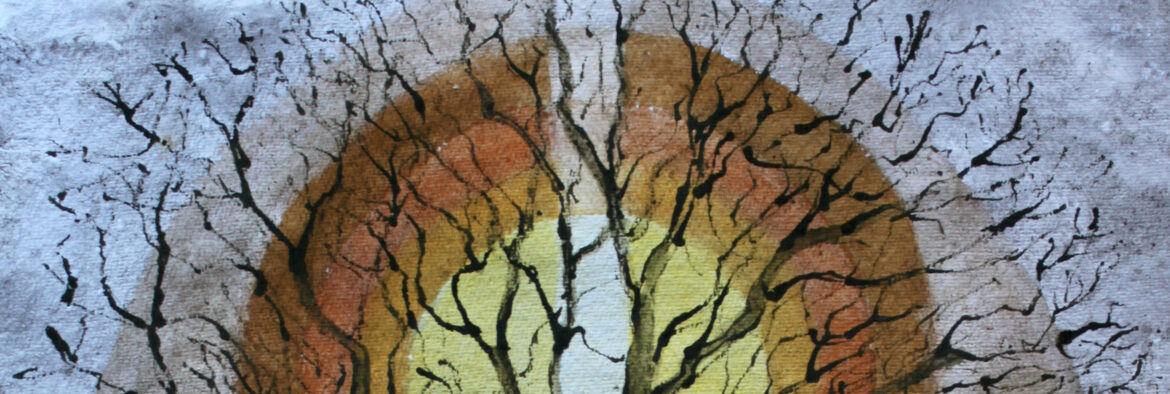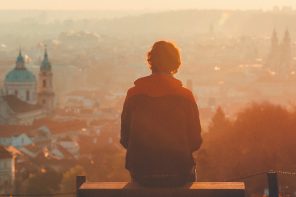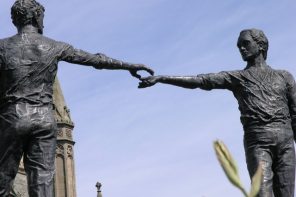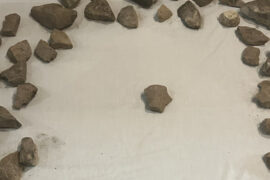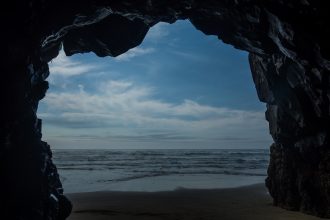When discussing the theme for the Transept exhibition in 2023, I immediately thought of connection as a way to make changes in our society: connecting with each other, with nature, with something greater than ourselves, and thinking about the point and space of connection. I then thought about bringing marginalised people into an expansive and inclusive centre, enfolded by a gestural movement that was painted with soil. During our brainstorming, the word off-centre was mentioned, which led me to see that a centre is not necessarily in the middle. When I began drawing, I realised that a centre could be unwelcoming, egoic and for the benefit of a few. I began to think about our institutions and started to draw cracks. I wanted to develop a kinder system, one held by the earth and aligned to something greater with an understanding that we are not separate.
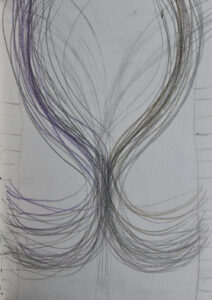 Drawings
Drawings
I process my emotions and thinking by drawing. I often draw from a place of not knowing with an empty mind. I start by making a few marks then instinct takes over. It feels as though the drawing emerges and I know what it means.
My immediate response to the theme enfolding was to make a gestural drawing. The gesture begins in the margins, meets in the middle and moves upwards and outwards creating an expanding circle, which is more inclusive before coming closer together at the top. This gesture is the central component of my work for the exhibition.
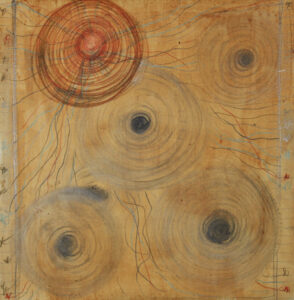 Drawing 1: The New Centre through Co-operation and Connecting
Drawing 1: The New Centre through Co-operation and Connecting
There are five circles all claiming to be the centre. Four suffer from ego fraudulence while the real centre, which is brightly coloured and includes the margins, is off-centre on the page.
Drawing 2: Centre Pushing Out the Margins
This centre is full of self-importance. In it the light is dimming. Earth is dimming due to climate change.[1] It seems relevant.
Drawing 3: Building Bridges
In contrast to drawing 2, people from the centre are empowering the margins. In this drawing there is space and light. Initially, I looked at margins in nature for inspiration and projects that were finding a way to connect them such as corridors of trees and woodlands and hedgehog subways.
Drawing 4: Meeting Point
The ‘meeting point’ is the point of connection. In my drawing, people from the margins come together at the meeting point. The ‘meeting point’ is something I have been interested in for a few months. I am particularly interested in the point where the roots meet the surface or where my feet meet the earth. The ‘meeting point’ is in both my paintings in the Exhibition.
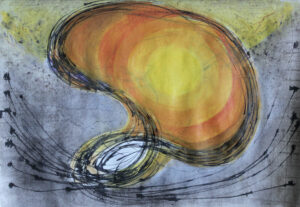 Drawing 5: We Are All the Same
Drawing 5: We Are All the Same
My final preparatory drawing was working out how I would paint the circle enclosed by the enfolding gesture. It is a series of circles, all containing the colour yellow, all but one containing orange, all but two containing a deeper orange etc. It alludes to the idea that we are all the same, we all have each other in us. For me, this called to mind what the poet and peace activist Thich Nhat Hanh said, ‘We are here to awaken from our illusion of separateness,’[2] and, elsewhere, ‘There’s no separation between self and other, and everything is interconnected.’[3]
A Diptych of Paintings
‘Enfolding, Connecting’
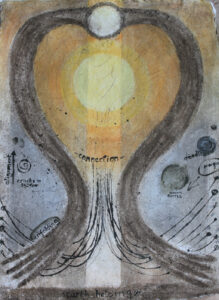 For the first painting in this diptych, I used soil, acrylic, coloured pencils, graphite and ink on paper. I began by covering the paper with a wash of soil and water, the soil from leaf mould, because, for me, it represents transformation. I then painted a thick layer of soil and water in the gestural shape using my hands. A white circle surrounded by earth emerged at the top. I liked that because it was the ‘meeting point’ a point of connection. After drawing lined paper with margins with graphite, I used a mixture of white paint and soil to cover the area between the margins and the enfolding gesture. This mixture represents unhealthy soil, contaminated by human activity.
For the first painting in this diptych, I used soil, acrylic, coloured pencils, graphite and ink on paper. I began by covering the paper with a wash of soil and water, the soil from leaf mould, because, for me, it represents transformation. I then painted a thick layer of soil and water in the gestural shape using my hands. A white circle surrounded by earth emerged at the top. I liked that because it was the ‘meeting point’ a point of connection. After drawing lined paper with margins with graphite, I used a mixture of white paint and soil to cover the area between the margins and the enfolding gesture. This mixture represents unhealthy soil, contaminated by human activity.
We are witnessing the decline of many of our institutions and systems, communications, political and transport being a few examples. I feel they are outdated, out of touch with too many rules and regulations. They feel clogged up with layers of bureaucracy and are not working for us any more. I drew cracks in the unhealthy soil to represent the cracks in our systems.
Before I painted the yellow, orange and brown circles, I left a space in the centre between vertical parallel lines from the bottom to the top to represent alignment. As Thomas Huebl, author of Healing Collective Trauma, writes, ‘by facilitating alignment between the personal self, the higher self and the light of Divine, instant healing can occur,’[4] and elsewhere, ‘when we live in alignment we live in the flow’.[5]
I felt my painting was lacking something. It wasn’t alive. I picked up a stick, dipped it in ink and made a mess. There are thumb marks, a spillage, doodles, writing and mistakes. It began to look much better.
The messiness and aliveness of being human contrasts with the peace and stillness emanating from the yellow and orange circles.
‘The Perfect System’
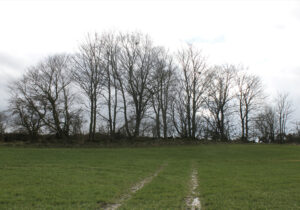 The second painting of the diptych celebrates the tree system. I have spent many months observing trees and the way they interact with each other. If a tree is given space, the roots grow into the margins, their branches don’t touch and the branches form a perfect semi-circle so that each branch gets as much light and space as possible. When two or more trees grow next to each other they form a group semi-circle from all angles.
The second painting of the diptych celebrates the tree system. I have spent many months observing trees and the way they interact with each other. If a tree is given space, the roots grow into the margins, their branches don’t touch and the branches form a perfect semi-circle so that each branch gets as much light and space as possible. When two or more trees grow next to each other they form a group semi-circle from all angles.
I used soil, acrylic, and ink on paper. I covered the paper with soil and water. I drew the roots in ink with a stick. I used soil and my fingers to surround the space where the roots meet the soil, the ‘meeting point’. From there I painted parallel earth lines for the tree to emerge. I also created a space between vertical parallel lines in the centre of the painting and the tree to represent alignment as I did in the first painting.
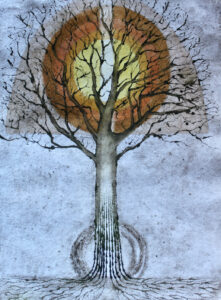 As in the first piece, I painted circles of yellow, orange and brown. I also painted a semi-circle to mirror the shape of the tree. I drew the tree and branches in ink with a stick. I painted the tree with soil. I looked at the painting a few days ago and realised the tree was not grounded and there was no flow. I dipped my stick in ink and drew lines vertically from the roots. Like the first painting it is these lines that bring the work to life. I now understand that drawing with ink has come to represent aliveness.
As in the first piece, I painted circles of yellow, orange and brown. I also painted a semi-circle to mirror the shape of the tree. I drew the tree and branches in ink with a stick. I painted the tree with soil. I looked at the painting a few days ago and realised the tree was not grounded and there was no flow. I dipped my stick in ink and drew lines vertically from the roots. Like the first painting it is these lines that bring the work to life. I now understand that drawing with ink has come to represent aliveness.
My work attempted to show alternative systems to the ones we have at present, ones that are enfolding, that include the margins, are for the good of the whole, are rooted in the earth, and that connect and align with Source, a Higher Intelligence, the Divine. I feel the tree system does this so successfully, and, hopefully, as I paint and write about it, I can share my enthusiasm and excitement.
I would like to thank Ewan Bowlby, who edited my first piece for Transpositions in 2021. I had not written anything for a while. He was kind, generous and supportive and made it easy for me. I am very grateful to him.
[1] P. R. Goode, E. Pallé, A. Shoumko, S. Shoumko, P. Montañes‐Rodriguez, and S. E. Koonin, ‘Earth’s Albedo 1998–2017 as Measured From Earthshine’ Geophysical Research Letters, 48 (2021), DOI: 10.1029/2021GL094888. [2] Thich Nhat Hanh, How to Connect (Ebury Publishing, 2020), 6. [3] Thich Nhat Hanh, ‘This is the Buddha’s Love,’ interview by Melvin McLeod, Shambhala Sun, March 1, 2006, https://plumvillage.org/about/thich-nhat-hanh/interviews-with-thich-nhat-hanh/shambhala-sun-march-2006-exclusive-interview/. [4] Thomas Huebl, ‘The Power of the Soul,’ LinkedIn, January 9, 2023, https://my.linkedin.com/posts/thomashuebl_collectivetrauma-soul-activity-7040773663440134144-3wfn. [5] Thomas Huebl, ‘What is the “Hidden Law”,’ Facebook, March 22, 2018, https://www.facebook.com/Thomas.Huebl.Sangha/videos/what-is-the-hidden-law/1857986477545060/.

